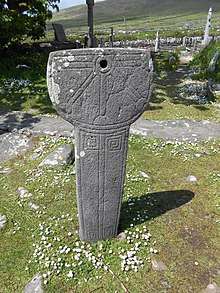Kilmalkedar
Kilmalkedar is a medieval ecclesiastical site and National Monument located in County Kerry, Ireland.[3][4][5][6]
Cill Maoilchéadair[1] | |
_Church_-_geograph.org.uk_-_275349.jpg) Church | |
 Location within Ireland | |
| Monastery information | |
|---|---|
| Other names | Cell-maeilchetair |
| Established | early 7th century AD |
| Disestablished | 12th century |
| Diocese | Ardfert and Aghadoe |
| People | |
| Founder(s) | Saint Maolcethair |
| Architecture | |
| Status | Inactive |
| Style | Celtic Christianity, Romanesque |
| Site | |
| Location | Kilmalkedar, Dingle Peninsula, County Kerry |
| Coordinates | 52.184775°N 10.33623°W |
| Visible remains | stone church, cross, oratory, holy well |
| Public access | yes |
National Monument of Ireland | |
| Official name | Kilmalkedar Early Medieval Ecclesiastical Site[2] |
| Reference no. | 65 |
Location
Kilmalkedar is on the Dingle Peninsula, 4.8 km (3.0 mi) east of Ballyferriter and 6.7 km (4.2 mi) northwest of Dingle.
History
Kilmalkedar is traditionally associated with Saint Brendan (c. AD 484 – c. 577), but also with a local saint, Maolcethair (Maol Céadair, Maol Céaltair, Malkedar;[7] died 636).[8]
The surviving church dates to the mid-12th century, with the chancel extended c. 1200.[9]
It was a traditional assembly site for pilgrims, who followed the Saint's Road (Casán na Naomh)[10] northeast to Mount Brandon.[11]
Some of the rituals carried out by locals, like performing nine clockwise circuits of the site on Easter Sunday, or the boring of holes in standing stones, suggest remnants of Celtic religion; Kilmalkedar may well have been a religious site long before Christianity arrived.[12]
Buildings
The church resembles Cormac's Chapel on the Rock of Cashel (built 1127–1134). Its nave is 8.28 m × 9.4 m (27.2 ft × 30.8 ft) with antae and steep gables. The chancel is 5.72 m × 5.1 m (18.8 ft × 16.7 ft) externally. The doorway is a notable Hiberno-Romanesque piece.[13][13] A hole in the east wall of the chancel is called "the eye of the needle"; if one can fit through it, one is certain to go to heaven.[12]
Pre-Romanesque remains include a corbelled building, perhaps a monastic cell; an alphabet stone; an Ogham stone; a sundial; a stone cross; and some bullauns.[8][14] One of the bullauns is associated with the mythical cow Glas Gaibhnenn.[15]
The alphabet stone is carved with "DNI" (domini) and the Latin alphabet in uncial script, carved c. AD 550–600.[16]
.jpg)
The Ogham stone (CIIC 187) reads ẠṆM MẠỊLE-INBIR/ MACI BROCANN ("Name of Máel-Inbher son of Broccán") and dates to c. AD 600.[17][18][19][20][21]
 Ogham stone, church, stone cross
Ogham stone, church, stone cross Hiberno-Romanesque doorway
Hiberno-Romanesque doorway- Doorway
- Alphabet stone
- blind arcade in the church
- Church, west elevation
 Sundial stone
Sundial stone- Stone cross
- Chancel exterior
| Wikimedia Commons has media related to Kilmalkedar. |
References
- "Cill Maoilchéadair/Kilmalkedar". Logainm.ie.
- National Monuments Service (2009-03-04). "National Monuments in State Care: Ownership & Guardianship" (PDF). Retrieved 2018-05-28.
- "Kilmalkedar Church, Dingle". TripAdvisor. Retrieved 2018-05-28.
- "Saints and Stones: Kilmalkedar Church (Cill Maolcheadair)". www.saintsandstones.net.
- "Proceedings of the Royal Irish Academy". Royal Irish Academy. 27 May 1864 – via Google Books.
- "Archaeologia Cambrensis: The Journal of the Cambrian Archoeological Association". Association. 27 May 1892 – via Google Books.
- Cormack, Margaret Jean (27 May 2018). "Saints and Their Cults in the Atlantic World". Univ of South Carolina Press – via Google Books.
- "St Maolcethair/St Malkedar, Kilmalkedar · The Corpus of Romanesque Sculpture in Britain & Ireland". www.crsbi.ac.uk.
- Jackman, Neil (11 May 2018). "Ireland's Wild Atlantic Way: A Guide to its Historic Treasures". The Collins Press – via Google Books.
- Carver, Martin (27 May 2018). "The Cross Goes North: Processes of Conversion in Northern Europe, AD 300-1300". Boydell Press – via Google Books.
- "Voices from the Dawn – The Gate of the Cow; Kilmalkedar Keelers Stone". voicesfromthedawn.com.
- Pemberton, Cintra (1 October 1999). "Soulfaring: Celtic Pilgrimage Then and Now". Church Publishing, Inc. – via Google Books.
- "The Antiquities of Kilmalkedar: Dingle Peninsula, Co Kerry – Ireland Travel Kit". www.irelandtravelkit.com.
- "Kilmalkedar Christian Site, Kerry". www.megalithicireland.com.
- http://www.megalithicireland.com/Kilmalkedar%20bullauns%20,%20Kerry.html
- "Kilmalkedar Alphabet Stone". www.corcadhuibhne3d.ie.
- "Kilmalkedar". www.corcadhuibhne3d.ie.
- Master, Web. "Kilmalkedar Church ~ Cill Mhaoilcéadair". www.dingle-peninsula.ie.
- "Ogham in 3D – Kilmalkedar / 187. Kilmalkedar". ogham.celt.dias.ie.
- https://voicesfromthedawn.com/gate-of-the-cow/
- https://pilgrimagemedievalireland.com/tag/the-cow-and-theif-stone-kilmalkedar/